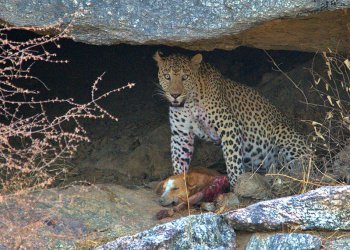The ecology and predator–prey dynamics of large felids in the tropics have largely been studied in natural systems where wild ungulates constitute the majority of the prey base. However, human-dominated landscapes can be rich in potential prey for large carnivores because of the high density of domestic animals, especially in tropical countries where pastoralism is an important livelihood activity. We report the almost complete dependence of leopards
Panthera pardus on domestic animals as prey in the crop lands of Ahmednagar district, Maharashtra, India. From analysis of 85 confirmed leopard scats, 87% of the leopard's prey biomass consisted of domestic animals, with 39% consisting of domestic dogs
Canis lupus familiaris alone. The only wild species that occurred in the leopard's diet were rodents, small indian civet
Viverricula indica, bonnet macaque
Macaca radiata and other primates
Semnopithecus spp., mongoose
Herpestes spp., and birds. Interviews conducted in 77 households distributed randomly in the study area documented a high density of domestic animals: adult cattle Bos taurus, calves, goats
Capra aegagrus, dogs and cats
Felis catus occurred at densities of 169, 54, 174, 24 and 61 per km
2, respectively. Ivlev's electivity index indicated that dogs and cats were over-represented in the leopard's diet, given the higher densities of goats and cattle. The standing biomass of dogs and cats alone was sufficient to sustain the high density of carnivores at the study site. Our results show that the abundance of potential domestic prey biomass present in human-use areas supports a relatively high density of predators, although this interaction could result in conflict with humans.

No comments:
Post a Comment